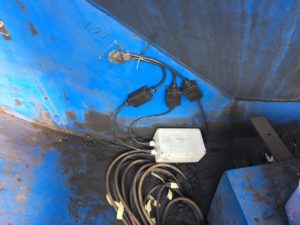SHM of GSU at Dhamra Port, Odisha
When Dhamra Port authorities approached us for FEM analysis of one of their large (2700 TPH) Grab Ship Unloader (GSU) for Structural Health Assessment of the GSU, we devised a complete methodology for SHM study. This GSU had already handled 7 million tons of coal in operation since 2011.

 We undertook complete modelling of the GSU in a FEM tool and installed stain gauges at critical points of the GSU structure for measurement of Stresses under various conditions of operation. Used Laser Photometric Measurement System (LPMS) to measure and record deflection of the boom with grab in operation and also the girder deflection on the land side. Comparing the filed results with analytical results on the FEM model we found the critical stresses and deflections are well within the threshold values that would cause any harm to the structure.
We undertook complete modelling of the GSU in a FEM tool and installed stain gauges at critical points of the GSU structure for measurement of Stresses under various conditions of operation. Used Laser Photometric Measurement System (LPMS) to measure and record deflection of the boom with grab in operation and also the girder deflection on the land side. Comparing the filed results with analytical results on the FEM model we found the critical stresses and deflections are well within the threshold values that would cause any harm to the structure.
 Also we undertook NDTs at critical areas of the GSU for locating any welding crack or crack initiation. All these are recorded and this record would form the basis of next SHM of this GSU after handling another 7 to 10 Million tons of coal. Areas of rust and general corrosion too are recorded and corrective action.
Also we undertook NDTs at critical areas of the GSU for locating any welding crack or crack initiation. All these are recorded and this record would form the basis of next SHM of this GSU after handling another 7 to 10 Million tons of coal. Areas of rust and general corrosion too are recorded and corrective action.
SHM of 104 year old Zerrut Bridge in Kolkata
The superstructure of the 40 m span Zerrut Bridge, a steel truss canal bridge in heart of Kolkata built in 1904 was expensively assessed by us for predicting it’s present capacity and life. Based on our data RITES, Government owned consulting agency prepared the report. Powergen and RITES devised a methodology for correct assessment of the capacity of the bridge under present day axle-capacity light & heavy vehicles that regularly plys on the bridge. We used LPMS for correct measurement of the deflection on the deck under various loading conditions. Axle loads of Heavy trucks plying on the bridge were recorded by means of Axle Load Pad Weigh machine. Multiple lorries were positioned incrementally to create various load patterns on the bridge deck. Bi-axial & tri-axial strain gauges were installed at pre-determined points and the Laser Sensing Screen of the LPMS was fitted to the central cross girder rigidly. Strain data from all points were transmitted by wireless devices to a central computer mounted in vehicle parked nearby.
 Deflection and stress readings were recorded under all conditions for analysis and report preparation.
Deflection and stress readings were recorded under all conditions for analysis and report preparation.
